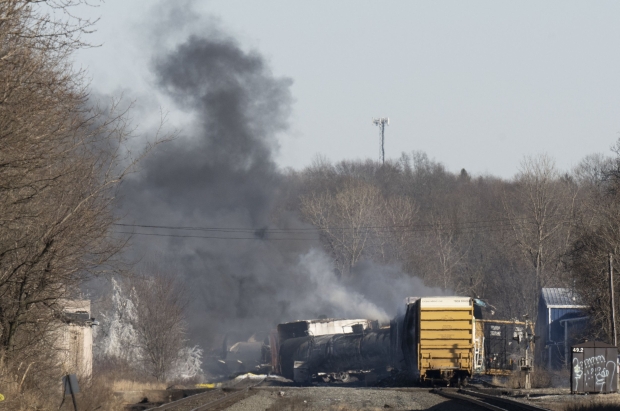Ohio Derailment Aftermath: Lingering Toxic Chemicals In Nearby Structures

Table of Contents
Contamination Pathways: How Toxic Chemicals Spread
The initial explosion and subsequent fire weren't the only sources of contamination. Toxic chemicals spread far beyond the immediate derailment site in East Palestine, Ohio, through several interconnected pathways:
-
Airborne Dispersion of Toxic Fumes: The burning of vinyl chloride and other hazardous materials released a plume of toxic fumes that spread across a wide area. These fumes potentially contaminated the air inside homes and buildings, leading to lingering chemical residue on surfaces and in ventilation systems.
-
Water Contamination Through Runoff and Groundwater Infiltration: Rainfall and snowmelt washed chemicals from the soil into nearby waterways, including streams and rivers. Groundwater infiltration poses a significant threat, potentially contaminating drinking water sources for years to come. This water contamination necessitates extensive testing and treatment to ensure the safety of the local water supply.
-
Soil Contamination Through Direct Contact and Leaching: The direct impact of the spilled chemicals and subsequent runoff resulted in significant soil contamination. Chemicals can leach into the groundwater, further expanding the contamination zone. This soil contamination presents long-term challenges for remediation and poses risks to plant and animal life.
-
Potential for Chemical Residue in Homes and Buildings Near the Site: The airborne dispersion of toxic fumes, combined with potential surface contamination, means that homes and buildings near the derailment site may harbor lingering chemical residues. Thorough cleaning and testing are crucial to assess the extent of this contamination.
-
Specific Chemicals and Lingering Effects: The derailment involved a variety of hazardous materials, including vinyl chloride, a known carcinogen, and butyl acrylate, an irritant. These chemicals have varying persistence in the environment, meaning their effects could linger for years, requiring sustained monitoring and cleanup.
Health Concerns: Long-Term Risks to Residents
The exposure to toxic chemicals released during and after the Ohio train derailment poses significant long-term health risks to residents in the affected area. These risks extend beyond immediate symptoms and encompass a range of potential health issues:
-
Respiratory Problems: Exposure to toxic fumes can lead to a range of respiratory problems, including asthma, bronchitis, and other chronic lung conditions. Long-term effects may include decreased lung function and increased susceptibility to respiratory infections.
-
Cardiovascular Issues: Certain chemicals released during the derailment are known to affect cardiovascular health, potentially increasing the risk of heart disease and stroke.
-
Neurological Disorders: Exposure to neurotoxic chemicals can damage the nervous system, leading to a range of neurological disorders, including cognitive impairment, memory loss, and other neurological symptoms.
-
Reproductive Health Problems: Some of the chemicals involved are known endocrine disruptors, which can interfere with hormone function and potentially lead to reproductive health problems.
-
Cancer Risks: Several chemicals released during the derailment are known carcinogens, significantly increasing the risk of various types of cancer. Long-term monitoring and research are vital to fully assess the cancer risk to the exposed population.
-
Ongoing Research: Multiple studies and research initiatives are underway to assess the long-term health impacts of the derailment on the residents of East Palestine and surrounding areas. These studies will be crucial in providing a comprehensive understanding of the health consequences and guiding appropriate medical interventions.
Environmental Impact: Long-term Effects on the Ecosystem
The Ohio train derailment's impact extends far beyond human health, causing significant and lasting damage to the local ecosystem:
-
Contamination of Local Water Sources: The contamination of local water sources, including drinking water, rivers, and streams, poses a severe threat to aquatic life and ecosystems. This contamination can lead to the death of fish and other aquatic organisms, disrupting the food chain and damaging the overall health of the ecosystem.
-
Impact on Wildlife and Plant Life: Exposure to toxic chemicals can have devastating effects on wildlife and plant life, leading to mortality, deformities, and reduced reproductive success. The long-term consequences for biodiversity in the area are concerning.
-
Disruption of Local Ecosystems: The widespread contamination disrupts the delicate balance of the local ecosystem, potentially leading to long-term ecological consequences. The recovery process could take years, if not decades.
-
Long-term Soil Remediation Challenges: The extent of soil contamination necessitates extensive and long-term remediation efforts. The process of removing or neutralizing contaminated soil is complex, time-consuming, and costly.
-
Potential for Bioaccumulation of Toxins: Toxic chemicals can bioaccumulate in the food chain, concentrating in higher trophic levels and ultimately posing risks to humans who consume contaminated food.
Ongoing Investigations and Remediation Efforts
Following the Ohio train derailment, various governmental agencies, including the Environmental Protection Agency (EPA), have launched investigations and remediation efforts:
-
Governmental Agencies Involved: Federal, state, and local agencies are collaborating to assess the extent of the contamination, monitor environmental conditions, and oversee cleanup efforts.
-
Testing and Monitoring Protocols: Extensive testing and monitoring protocols are in place to assess the levels of contamination in air, water, and soil. This data informs remediation strategies and risk assessments.
-
Cleanup Methods Being Employed: A range of cleanup methods are being employed, including soil excavation, water treatment, and air purification. The effectiveness and long-term implications of these methods require careful evaluation.
-
Challenges in Containing and Removing Contaminants: Containing and removing the contaminants poses significant challenges, given the widespread nature of the contamination and the persistence of some chemicals.
-
Transparency and Communication: Open and transparent communication with the affected community is crucial to building trust and ensuring public safety. Regular updates on the investigation and cleanup progress are necessary.
Community Response and Support
The community's response to the Ohio train derailment has been marked by resilience, advocacy, and a demand for accountability:
-
Community Organizing and Advocacy Groups: Community groups have formed to advocate for their rights, demand transparency from authorities, and support affected residents.
-
Health Screenings and Support for Affected Residents: Efforts are underway to provide health screenings and support for residents affected by the derailment, addressing both immediate and long-term health concerns.
-
Legal Action and Accountability: Legal action is being pursued to hold responsible parties accountable for the disaster and its consequences.
-
Long-term Support and Resource Allocation: Sustained long-term support and resource allocation are crucial to address the ongoing health and environmental challenges resulting from the derailment.
Conclusion
The Ohio train derailment’s aftermath highlights the devastating and long-lasting impact of toxic chemical spills on human health and the environment. The lingering presence of these chemicals in nearby structures, water sources, and soil presents significant long-term risks. We've seen the contamination pathways, the potential for severe health issues, the damage to the ecosystem, the ongoing cleanup efforts, and the community's response. The need for continued monitoring, thorough investigation, and comprehensive cleanup efforts to mitigate the lingering effects of the Ohio train derailment is paramount. We must support affected communities and advocate for stronger regulations to prevent future disasters involving the transport of hazardous materials. Continued vigilance and action are essential to ensuring the safety and well-being of the residents of East Palestine and the protection of the environment. Let's work together to address the long-term effects of this Ohio derailment and ensure a safer future. We must prioritize Ohio derailment cleanup, Ohio toxic chemical cleanup, and address the long-term effects of the Ohio derailment effectively.

Featured Posts
-
 Tugruls Insights Osimhens Transfer Speculation Diet And Napolis Plans
May 27, 2025
Tugruls Insights Osimhens Transfer Speculation Diet And Napolis Plans
May 27, 2025 -
 Put Ukrainy V Nato Obeschaniya Germanii I Dalneyshie Shagi
May 27, 2025
Put Ukrainy V Nato Obeschaniya Germanii I Dalneyshie Shagi
May 27, 2025 -
 Alien Earth Shorts Uncovering 6 Easter Eggs From Sxsw 2025
May 27, 2025
Alien Earth Shorts Uncovering 6 Easter Eggs From Sxsw 2025
May 27, 2025 -
 Family Of Indigenous B C Youth Who Died In Care Believe She Froze To Death
May 27, 2025
Family Of Indigenous B C Youth Who Died In Care Believe She Froze To Death
May 27, 2025 -
 10 Marzo Almanacco Giornaliero Compleanni Santo E Detti
May 27, 2025
10 Marzo Almanacco Giornaliero Compleanni Santo E Detti
May 27, 2025
Latest Posts
-
 Samsung Undercuts Apple 101 Tablet Deal Announced
May 31, 2025
Samsung Undercuts Apple 101 Tablet Deal Announced
May 31, 2025 -
 Is Samsungs 101 Tablet A Smart I Pad Alternative
May 31, 2025
Is Samsungs 101 Tablet A Smart I Pad Alternative
May 31, 2025 -
 Samsungs 101 Tablet A Competitive I Pad Alternative
May 31, 2025
Samsungs 101 Tablet A Competitive I Pad Alternative
May 31, 2025 -
 Cheaper Than An I Pad Samsungs 101 Tablet Deal
May 31, 2025
Cheaper Than An I Pad Samsungs 101 Tablet Deal
May 31, 2025 -
 Budget Tablet Showdown Samsungs 101 Offer Vs Apple I Pad
May 31, 2025
Budget Tablet Showdown Samsungs 101 Offer Vs Apple I Pad
May 31, 2025
